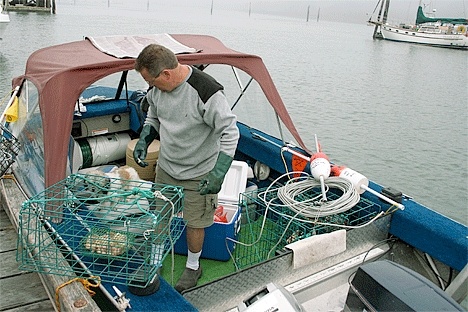Crab cakes, crab fritters, crab salad, crab bisque or just plain steamed crab right out of the shell: Beginning Wednesday, July 1, you can fulfill your delectable crustacean dreams by catching your own crab from Whidbey Island’s briny deep.
Don Velasquez, Fish and Wildlife biologist for the Washington Department of Fish and Wildlife, said this week that the prized Dungeness crabs are out there, all you have to do is go out and get them.
“Right now, things aren’t looking too bad,” he said. “The Tualip tribe had their opener and fished mostly in Area 8-2, and they did about as well as expected.”
The other tribes fished mainly in Area 8-1.
Velasquez said commercial crab fishing has been doing pretty well and catch numbers are about equal what has been caught in previous years.
WDFW officials report more than 220,000 recreational crab licenses were sold this year, making the sport one of the most popular outdoor activities in the state.
Recreational crab fishing will begin in Areas 8-1, 8-2 and 9 around Whidbey Island at 7 a.m. Wednesday, July 1, and will close Monday, Sept. 7, for a catch assessment.
As far as crab counts go, Areas 8-1 and 8-2 are combined and they have a target of 350,000 pounds. With each crab weighing approximately 1.8 pounds, that is a lot of Dungeness crab.
Velasquez said last year the harvest count in areas 8-1 and 8-2 was estimated at 504,000 pounds.
In Area 9, the target in 2009 is 62,000 pounds.
Commercial pots have to be out of the water by 8 p.m. Tuesday, June 30, giving recreational crabbers time to get out and make their sets at 7 a.m. the following day.
Crabbers are reminded to make sure to have the proper biodegradable escape cords on their pots. Ingri Johnson, member of the Island County Beach Watchers, said crab inside a lost pot with a biodegradable cord are able to escape and others are unable to get in.
Officials estimate 372,000 crab die in lost pots each year when biodegradable cords are not used.
Velazquez said this will also be the first year penalties will be imposed for failure to report catch records. A $10 penalty will be applied to next year’s crabber’s license for those who fail to report.
There are several hot spots locally for crab, particuarly Crescent Harbor, which has become the most popular spot to drop pots in the past few years.
Other good places around the island include the Saratoga Passage, Snakelum Point near Harrington Lagoon and Cornet Bay.
One of the more popular baits to draw crab is herring, but chicken parts also make good bait. Crab are scavengers and will eat just about anything, but it is important to keep your bait fresh and never toss away old bait in an area where you set your pots.
Make sure to keep the bait box elevated off the bottom of the pot so it doesn’t become fouled with mud and silt. By doing this, the crab will have good access to the bait.
Also, make sure you have enough weight on your pots so they don’t get blown around if a storm comes up. Crab pots can be expensive, and you don’t want to lose any because of bad weather.
The daily catch limit in Puget Sound is five Dungeness crab, males only, in hard-shell condition with a minimum carapace width of six and one-quarter inches. In addition, fishers may catch six red rock crab of either sex per day, provided those crab measure at least five inches across.
Additional information is available on the WDFW Web site at wdfw.wa.gov/fish/shelfish/crab/index.htm.



